Anatomy for Beginners is a television show created by Gunther von Hagens.
In this 4-part series, von Hagens and Professor John Lee demonstrated the anatomical structure and workings of the body. The 4 episodes (Movement, Circulation, Digestion, and Reproduction) were screened in the United Kingdom on Channel 4 in 2005.
The show features public anatomy demonstrations with the use of real human cadavers and live nude models (for surface anatomy and surface markings), carried out at von Hagens' Institute for Plastination in Heidelberg, Germany.
Von Hagens’ public demonstrations are not formal anatomy dissections performed by medical students in some countries as part of their medical training. Actual formal dissections are performed slowly and take dozens of hours of dissection. Anatomy for Beginners performs quicker autopsy procedures, and also combines demonstrations of plastinated body parts and specimens to give a glimpse of human anatomy.
The individuals on whom the demonstrations were performed had, before their death, enrolled in von Hagens’ body donor programme and consented to the use of their bodies for public education in anatomy, including public demonstration.

Anatomy is the branch of biology concerned with the study of the structure of organisms and their parts. Anatomy is a branch of natural science which deals with the structural organization of living things. It is an old science, having its beginnings in prehistoric times. Anatomy is inherently tied to developmental biology, embryology, comparative anatomy, evolutionary biology, and phylogeny, as these are the processes by which anatomy is generated, both over immediate and long-term timescales. Anatomy and physiology, which study the structure and function of organisms and their parts respectively, make a natural pair of related disciplines, and are often studied together. Human anatomy is one of the essential basic sciences that are applied in medicine.

Aelius Galenus or Claudius Galenus, often Anglicized as Galen or Galen of Pergamon, was a Greek physician, surgeon and philosopher in the Roman Empire. Considered to be one of the most accomplished of all medical researchers of antiquity, Galen influenced the development of various scientific disciplines, including anatomy, physiology, pathology, pharmacology, and neurology, as well as philosophy and logic.

Andreas Vesalius was a 16th-century anatomist, physician, and author of one of the most influential books on human anatomy, De Humani Corporis Fabrica Libri Septem. Vesalius is often referred to as the founder of modern human anatomy. He was born in Brussels, which was then part of the Habsburg Netherlands. He was a professor at the University of Padua (1537–1542) and later became Imperial physician at the court of Emperor Charles V.
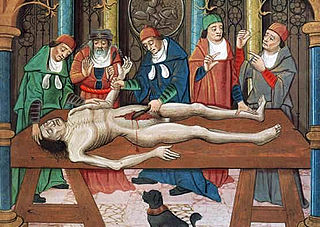
The history of anatomy extends from the earliest examinations of sacrificial victims to the sophisticated analyses of the body performed by modern anatomists and scientists. Written descriptions of human organs and parts can be traced back thousands of years to ancient Egyptian papyri, where attention to the body was necessitated by their highly elaborate burial practices.

Body Worlds is a traveling exposition of dissected human bodies, animals, and other anatomical structures of the body that have been preserved through the process of plastination. Gunther von Hagens developed the preservation process which "unite[s] subtle anatomy and modern polymer chemistry", in the late 1970s.

Herophilos, sometimes Latinised Herophilus, was a Greek physician deemed to be among the earliest anatomists. Born in Chalcedon, he spent the majority of his life in Alexandria. He was the first scientist to systematically perform scientific dissections of human cadavers. He recorded his findings in over nine works, which are now all lost. The early Christian author Tertullian states that Herophilos vivisected at least 600 live prisoners; however, this account has been disputed by many historians. He is often seen as the father of anatomy.

The history of anatomy in the 19th century saw anatomists largely finalise and systematise the descriptive human anatomy of the previous century. The discipline also progressed to establish growing sources of knowledge in histology and developmental biology, not only of humans but also of animals.
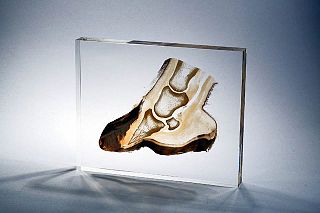
Plastination is a technique or process used in anatomy to preserve bodies or body parts, first developed by Gunther von Hagens in 1977. The water and fat are replaced by certain plastics, yielding specimens that can be touched, do not smell or decay, and even retain most properties of the original sample.

Dissection is the dismembering of the body of a deceased animal or plant to study its anatomical structure. Autopsy is used in pathology and forensic medicine to determine the cause of death in humans. Less extensive dissection of plants and smaller animals preserved in a formaldehyde solution is typically carried out or demonstrated in biology and natural science classes in middle school and high school, while extensive dissections of cadavers of adults and children, both fresh and preserved are carried out by medical students in medical schools as a part of the teaching in subjects such as anatomy, pathology and forensic medicine. Consequently, dissection is typically conducted in a morgue or in an anatomy lab.

Body snatching is the secret removal of corpses from burial sites. A common purpose of body snatching, especially in the 19th century, was to sell the corpses for dissection or anatomy lectures in medical schools. Those who practised body snatching were often called "resurrectionists" or "resurrection-men". A related act is grave robbery, uncovering a tomb or crypt to steal artifacts or personal effects that had been buried with the deceased; however, grave robbery differs from body snatching in that grave robbing does not involve stealing the corpse itself.

A prosector is a person with the special task of preparing a dissection for demonstration, usually in medical schools or hospitals. Many important anatomists began their careers as prosectors working for lecturers and demonstrators in anatomy and pathology.
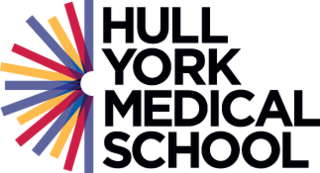
Hull York Medical School (HYMS) is a medical school in England which took its first intake of students in 2003. It was opened as a part of the British Government's attempts to train more doctors, along with Brighton and Sussex Medical School, Peninsula Medical School and University of East Anglia Medical School.
John Andre Lee is a retired English pathologist who was formerly clinical professor of pathology at Hull York Medical School and consultant histopathologist at Rotherham General Hospital, later becoming the Rotherham NHS Foundation Trust's Director of Cancer Services. Lee gained a BSc and a PhD in physiology at University College London, and then a medical degree subsequently specialising in pathology.
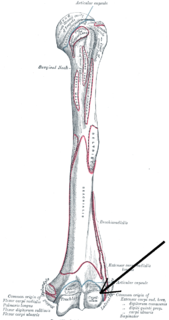
In human anatomy of the arm, the capitulum of the humerus is a smooth, rounded eminence on the lateral portion of the distal articular surface of the humerus. It articulates with the cupshaped depression on the head of the radius, and is limited to the front and lower part of the bone.
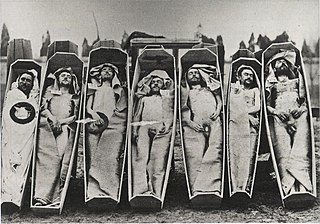
A cadaver or corpse is a dead human body that is used by medical students, physicians and other scientists to study anatomy, identify disease sites, determine causes of death, and provide tissue to repair a defect in a living human being. Students in medical school study and dissect cadavers as a part of their education. Others who study cadavers include archaeologists and arts students.

Pandit Madhusudan Gupta was a Bengali Brahmin translator and Ayurvedic practitioner who was also trained in Western medicine and is credited with having performed India's first human dissection at Calcutta Medical College (CMC) in 1836, almost 3,000 years after Susruta.
A prosection is the dissection of a cadaver or part of a cadaver by an experienced anatomist in order to demonstrate for students anatomic structure. In a dissection, students learn by doing; in a prosection, students learn by either observing a dissection being performed by an experienced anatomist or examining a specimen that has already been dissected by an experienced anatomist
The history of pathology can be traced to the earliest application of the scientific method to the field of medicine, a development which occurred in the Middle East during the Islamic Golden Age and in Western Europe during the Italian Renaissance.
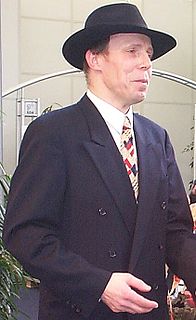
Gunther von Hagens is a German anatomist who invented the technique for preserving biological tissue specimens called plastination. He has organized numerous Body Worlds public exhibitions and occasional live demonstrations of his and his colleagues' work, and has traveled worldwide to promote its educational value. The sourcing of biological specimens for his exhibits has been controversial, but he insists that informed consent was given before the death of donors, and extensive documentation of this has been made available.
The Pennsylvania Anatomy Act of 1883 is legislation of the State of Pennsylvania to facilitate medical education. This act allowed teachers and students to be able to dissect bodies without have to resort to buying from grave robbers or buying body parts. This act was written to prevent grave robbing, and to even out the availability of corpses.